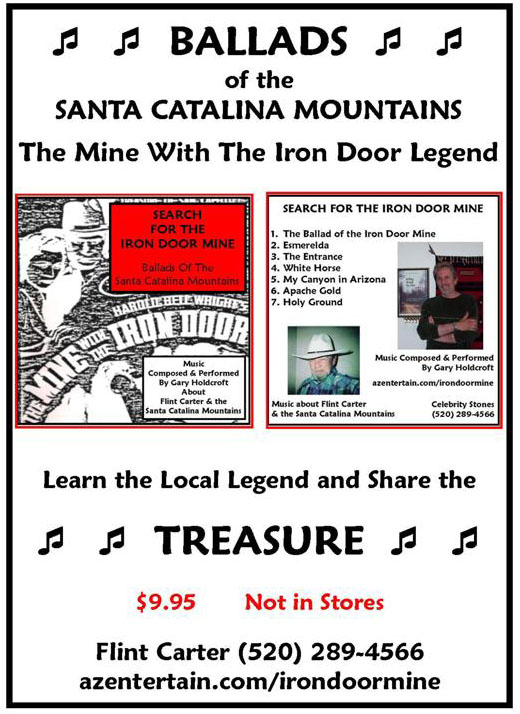|
Entertainment Magazine: Tucson: Lost City Artifacts discovered in the Santa Catalina Mountains
The Santa Catalina mountains, north of Tucson, Arizona have been inhabited for thousands of years. Only the last 150 years of activity have been recorded through mining records, book references and newspaper articles. The rest of the story is told in the relics that were left behind. Evidence of Sapnaish, Mexican and early American mining has been documented throughout the Santa Catalinas. Some of the artifacts maybe from from the lost Santa Catalina Mission. 1812 Mexican Coin FoundDuring an expedition to the Lost City of the Santa Catalinas in 1995, one of the members of Carter’s group included George Mroczkowski, author of the “Professional Treasure Hunter,” found an 1812 Mexican coin in front of a caved-in tunnel. The coin was unearthed near a tunnel on the west side of Oracle Ridge. The buried coin may have been from a payment made to a Mexican or early Anglo miner and lost in the dirt. Both items were turned over to the U.S. Forest Service and reviewed by the Arizona Historical Society. Miners could have used the iron pick because the Iron Door legend indicates the mine was so rich, the gold was cut out by a hacheta that resembled in shape and size the recovered artifact. The copper coin is determined to be an authentic Mexican 1812 two-real piece minted by the Insurgent Government of José Maria Morelos, one of the fathers of Mexican Independence. It is unlikely it was used as payment for miners because in the mid to late 19th century Americans conducted business mostly in Mexican gold and silver. The iron pick could not be explained either. Since there were mining activities in the area during the early to mid-1800s, it could help explain the discovery of an 1812 Mexican coin at nearby Catalina Camp. Prior to the Americans only Mexicans and maybe the Spaniards mined the area. This is an exerpt from "Treasures of the Santa Catalinas" by Robert Zucker, author, publisher Entertainment Magazine and former instructor and by Flint Carter, researcher, local mining operator and prospector.
|

 "Ballads of the Santa Catalina Mountains" CD
"Ballads of the Santa Catalina Mountains" CD Flint
Carter, a Tucson, Arizona miner, has samples of "Cody Stone" mined in
the Santa Catalina Mountains of Southern Arizona. This stone is
jewelry grade silver and quartz ore, and weighs 8 pounds or more. It
also contains scheelite and fluoresces. Valued at $5 a carat. This
particular piece is the second largest specimen recovered. Extremely
rare. There is a 40 page provenance of the object, including an
assay by the University of Arizona and opinions from the
Gem Institute of America and other sources. More samples of
Flint
Carter, a Tucson, Arizona miner, has samples of "Cody Stone" mined in
the Santa Catalina Mountains of Southern Arizona. This stone is
jewelry grade silver and quartz ore, and weighs 8 pounds or more. It
also contains scheelite and fluoresces. Valued at $5 a carat. This
particular piece is the second largest specimen recovered. Extremely
rare. There is a 40 page provenance of the object, including an
assay by the University of Arizona and opinions from the
Gem Institute of America and other sources. More samples of